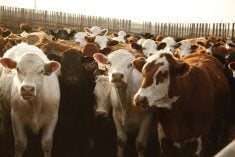A national movement document for tracking livestock around the country is in development.
“It would save a lot of grief in the whole traceability system,” said rancher Erik Butters, who sits on a special committee discussing a standardized document similar to the livestock manifests used in Alberta. The committee is meeting in early January to further develop a national form.
It would probably list premise identification numbers, the origin of the cattle and where they are going. He represents the Canadian Cattlemen’s Association on the committee. The CCA has long argued against going too far with traceability, especially if it costs producers money and is difficult to use.
Read Also

Growth plates are instrumental in shaping a horse’s life
Young horse training plans and workloads must match their skeletal development. Failing to plan around growth plates can create lifelong physical problems.
“CCA supports moving toward a robust traceability system but at a pace that is doable and is acceptable in the country. If you make everybody mad in the country it is not going to work,” he said.
A document like this could prove indispensable for tracing livestock during a disease outbreak, said Dave Moss, head of Alberta’s Livestock Inspection Services.
Albert is moving toward an electronic manifest but some provinces do not appear to have similar paperwork or regulations attached to livestock transactions so creating a national, standardized form will take time.
“It is a fairly easy discussion to have Manitoba west,” he said. Quebec has a movement document while the other provinces have a variety of documents that may provide similar information when livestock is traded.
The committee has a project scope and is discussing all the manifests currently in use and a sample data set of what they think is required information on any livestock movement.
“An infectious disease is all about the movement of groups. You can read the tags once you have them quarantined but you’ve got to stop the movement and you need to know where cattle went,” Moss said.
If a single sick animal arrived at an auction market, the assumption is all were infected and it is critical to know where they went and stop further movement.
“I think there is an understanding now that commerce can be a very effective way of tracking that movement information and not have the angst of having traceability. You can enable commerce to give you that traceability data,” he said.
How and where data might be housed is still under discussion.















